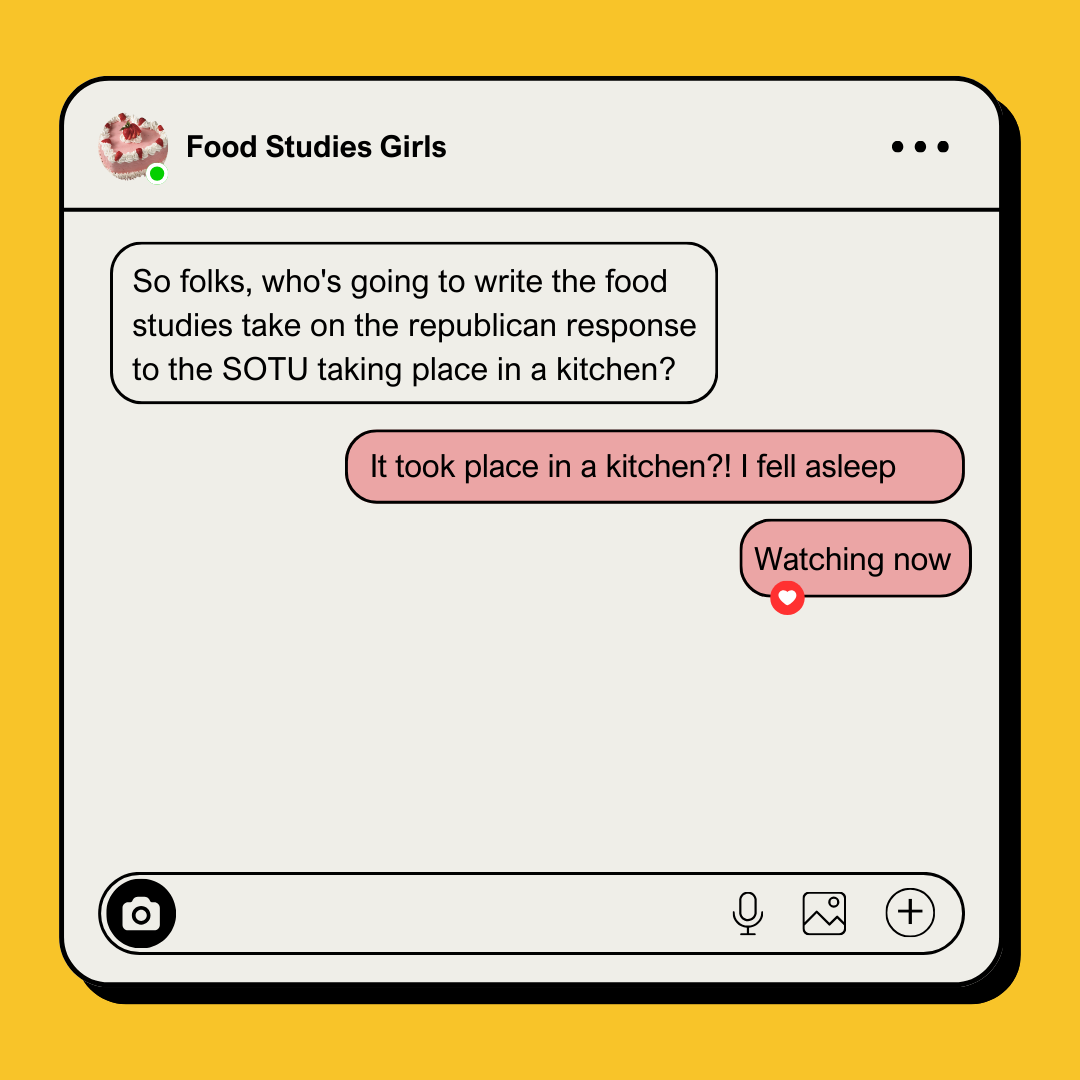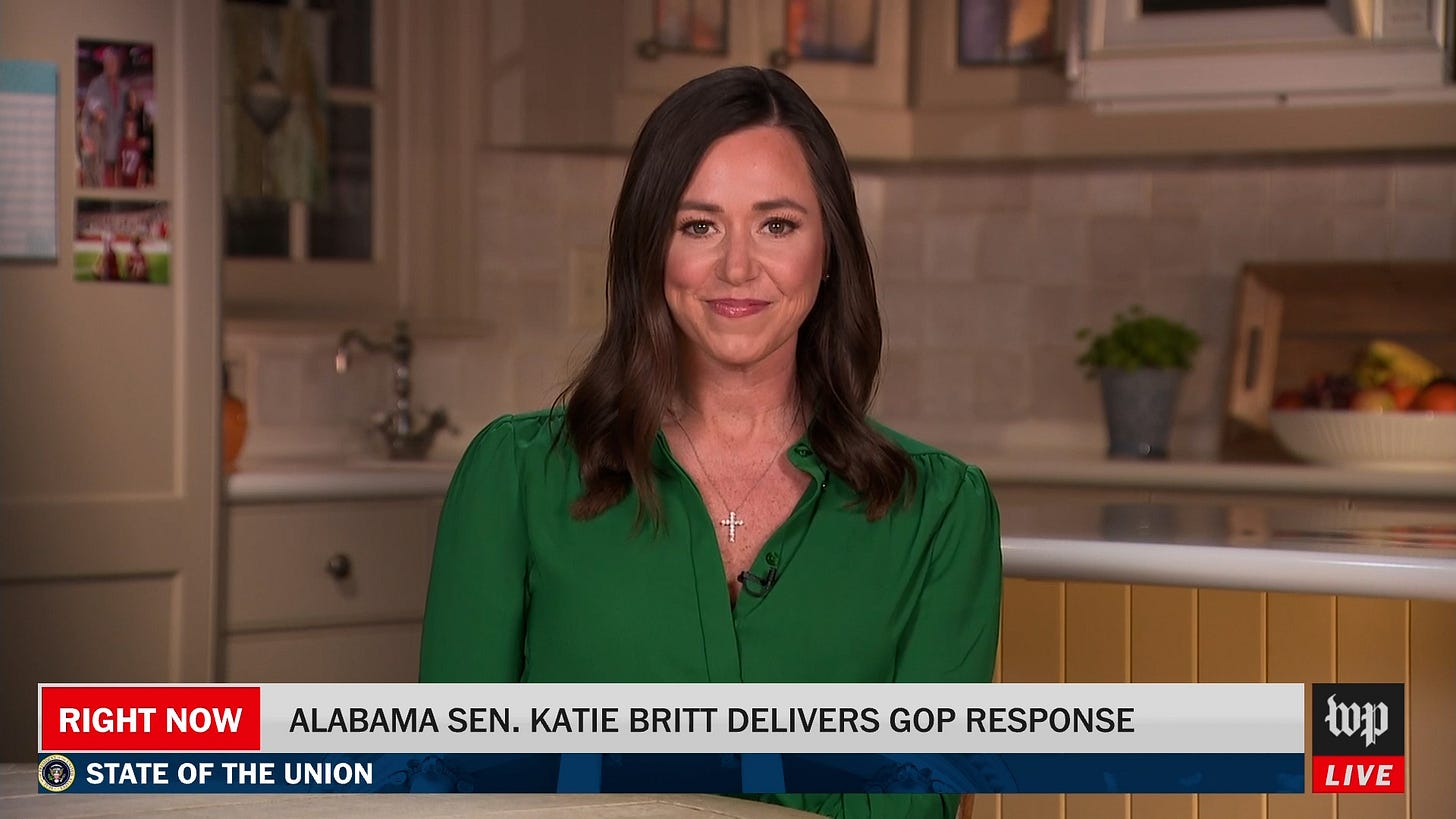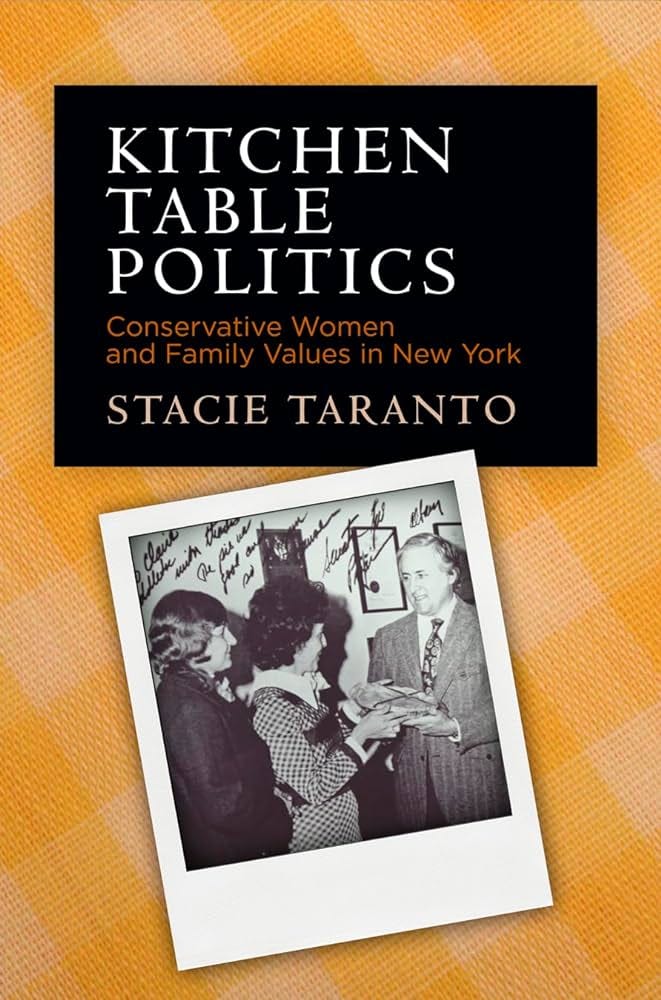Coming back from a cozy writing break because, well, I couldn’t let this little food history moment slip by without a few choice words. I’ll be back soon with more!
I woke up to several missed texts from my Food Studies Girls group chat (yes, we have a group chat and we have a separate group chat that includes our one close Food Studies boy friend and yes we frequently get these group chats confused). Here’s a replay:
So I fell asleep during the State of the Union (I’m a working parent of two small children and the thing didn’t start till 9 PM, the outcome was inevitable), which means I missed the follow-up Republican Response. This year’s response was given by Alabama Senator Katie Britt, 42, while sitting from her kitchen table.
Perhaps there was a practicality to Sen. Britt’s location? It was a late event, she is a working parent, the convenience to stay home can’t be dismissed. A few minutes into her speech, however, the strategy in the location is made clear as she wishes Biden “understood what real families are facing around kitchen tables just like this.”
In addition to speaking on the historical and cultural implications of this choice, I believe my Food Studies Girls also wanted me to unpack Britt’s kitchen aesthetics (Trad Wives were mentioned further down in the chat), but those details aren’t the focus here.
This is about the concept of the kitchen as a place of political strategy and an object long used as both a metaphor and a site of real action in the long history of women’s material culture. Britt was not the first women to use the kitchen as a political battleground and she wont be the last. Kitchens will continue to be spaces of political narratives until women’s equality is protected constitutionally and gendered expectations around domestic duties like cooking are dispelled and further dismantled with the support of systemic infrastructural changes. This progress is the exact opposite of what Britt and her party wants, which is why her use of the kitchen for this speech is a unique choice.
Fellow Republicans and conservative commentators also found the choice odd. X (formerly Twitter) was evidently abuzz with disparaging comments and jokes including Charlie Kirk, the founder of the conservative youth organization Turning Point USA, who claimed that Britt looked like she was “she’s hosting a cooking show.” Conservative commentator Alyssa Farah Griffin wrote that she did “not understand the decision to put her in a *KITCHEN* for one of the most important speeches she’s ever given.” Raise your hand if you know why she was put there.
A Very Abridged Women’s History Lesson
Here is a super quick primer on women’s long history of gendered expectations related to food and cooking:
Women were relegated to the kitchen and other domestic food-related spaces. In this relegation, we still found moments for joy, creativity, and the chance to create expertise and tradition. Nonetheless, this relegation was still an oppression—importantly, it was and is carried differently by women of varying means and skin colors—but an oppression by all definitions. These factors combined to make the kitchen the perfect place for radical everyday action, which is why you can be a woman who enjoys cooking for your family AND a woman who fights for equality, reproductive rights, Black lives, and so much more.
Here are a few of my favorite US-focused historical examples of women using the kitchen as a place of progressive political activism:
The woman-led Edenton Tea Party boycott in 1774 that created a thoughtful plan of resistance using their consumer power (only to be mocked and forgotten for the stupid and racist version conducted up in Boston).
Late 19th-century Suffragists centered their platform around food safety and domestic duties (knowing that men would elect them if they still planned to stay in the kitchen, but also aware that the US was in desperate need of food safety administration).
Early 20th-century Suffragists created pop-up lunch rooms to sell food and convince male voters to agree to women’s enfranchisement.
Civil Rights activists, including the now well-known Georgia Gilmore, cooked food and baked goods from their home kitchens to raise funds for the movement and feed other activists.
Martha Rosler’s 1975 political performance piece “Semiotics of the Kitchen”
Bakers Against Racism and the amazing work done by home bakers here in the US and all over the world over the past few years!
Kitchen Table Politics
The concept of “Kitchen Table Politics” or “Dinner Table Politics” isn’t new and versions of the phrase have been used on both sides of the aisle for decades. The tricky part is that both sides want to use women’s lived experiences in kitchens for political advantage and, increasingly as time goes on, do not want to appear as if they forcing women to be in that kitchen. The fact that this is well worn political ground is partly why the reasoning to put Britt in a kitchen for this speech seems so off. What did the GOP hope to gain with this placement? Did they aim to appeal to a growing demographic of traditional mothers and housewives (i.e. Trad Wives)? If she had cooked something or had been feeding her children would it have made the situation seem more real or would it have truly turned her into a cooking show host? Most likely they wanted her to appear to remain within what historian Stacie Taranto calls the “parameters of acceptable politics,” which, for women, includes whatever you can buy at the grocery store.
Returning to Britt’s rhetoric, her speech consistently relies on very real issues like childcare and cost of living, but the central theme is still focused on the kitchen. While sitting at her kitchen table, the repeated use of concepts such as “hunger,” “empty kitchen chairs,” and accusing the president of not recently pushing “a grocery cart,” makes plain that her speech isn’t just for the average American citizen, but for women voters — and, in reality, women who look like her.
Even when it Britt expands her political sights to other issues beyond the kitchen, including the global impacts of Hamas terrorists, she quickly circles back to her key viewer, Mrs. Consumer, with the jump scare: “They’ve targeted commercial shipping.”
A few minutes later, the rhetoric continues with a direct appeal to “fellow moms” in the kitchen:
“Many of whom will be tossing and turning at 2 am wondering how they are going to be three places at once tomorrow and somehow still get dinner on the table…Our future starts around kitchen tables just like this.”
Britt’s invocation of the kitchen as a place for political grandstanding flopped because someone, probably one of her male advisors, only thinks of her as a woman and by stereotypical extension as a mother and a wife, so a kitchen *just makes sense.* Or as Scarlett Johansson said while playing Sen. Britt on Saturday Night Live, it was because “Republicans wanted me to appeal to women voters and women love kitchen.” By this logic, she could have delivered the same speech from a sewing circle, the mall, or even the tampon and panty liner aisle.
And therein lies the potential danger of kitchen table politics: sometimes you don’t know who’s coming to dinner.
Pairs well with:
For a great little macro read on the subject at hand, pick up Kitchen Table Politics: Conservative Women and Family Values in New York by Stacie Taranto.










Totally tangential but every year for the last 7 years or so I've received an Anne Taintor calendar as a Christmas gift and I love it.
Such a great read. Excited to dive a bit more into those historical moments when the kitchen was used for activism — love learning from you!